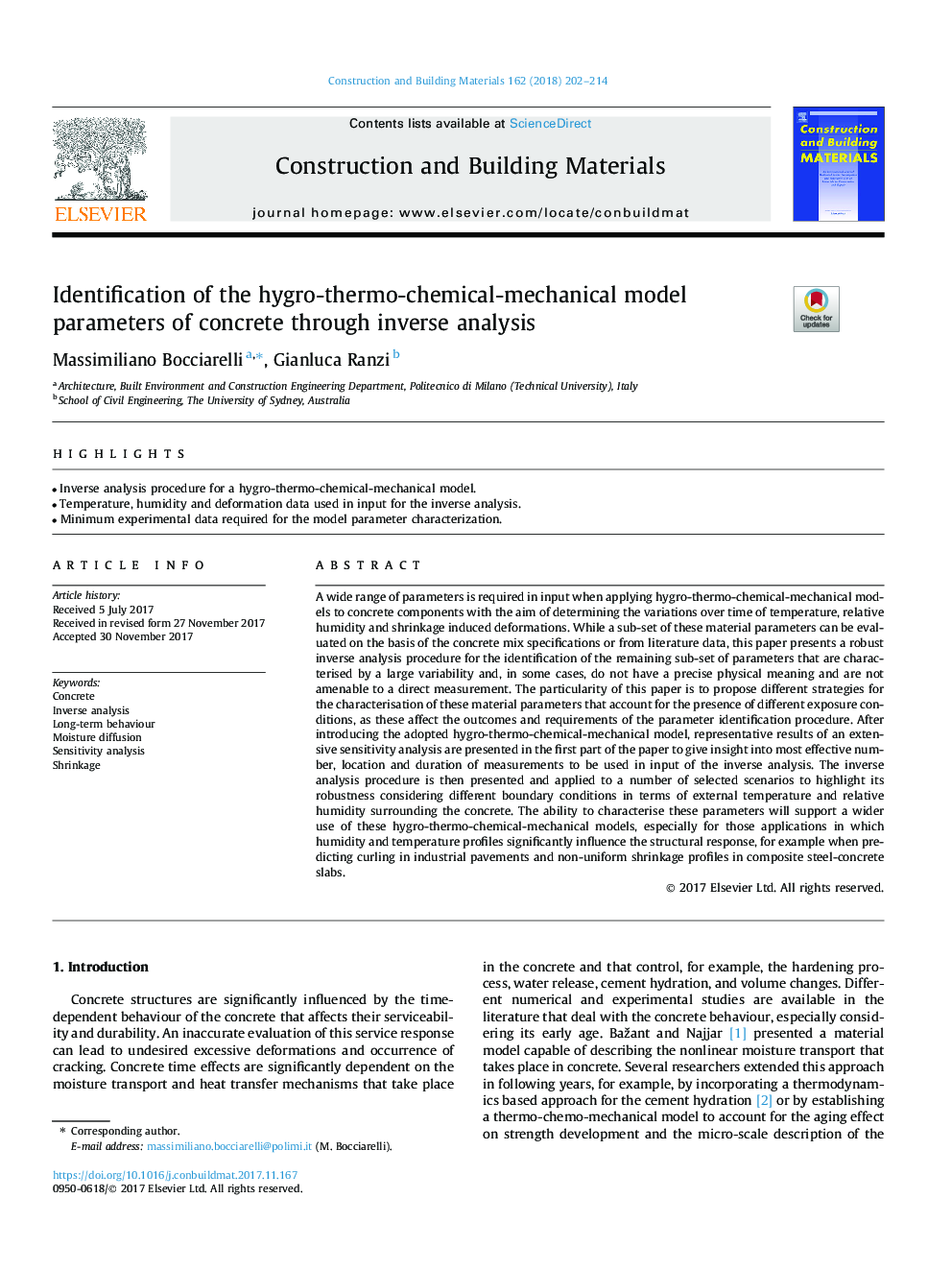| کد مقاله | کد نشریه | سال انتشار | مقاله انگلیسی | نسخه تمام متن |
|---|---|---|---|---|
| 6716450 | 1428744 | 2018 | 13 صفحه PDF | دانلود رایگان |
عنوان انگلیسی مقاله ISI
Identification of the hygro-thermo-chemical-mechanical model parameters of concrete through inverse analysis
ترجمه فارسی عنوان
شناسایی پارامترهای مدل هیرو-ترمو-شیمیایی-مکانیکی بتن از طریق تحلیل معکوس
دانلود مقاله + سفارش ترجمه
دانلود مقاله ISI انگلیسی
رایگان برای ایرانیان
کلمات کلیدی
بتن، تجزیه و تحلیل معکوس، رفتار بلند مدت، انتشار رطوبت، تجزیه و تحلیل میزان حساسیت، انقباض،
ترجمه چکیده
طیف گسترده ای از پارامترها در ورودی هنگام استفاده از مدل های هیرو-ترمو-شیمیایی-مکانیکی برای اجزای بتن با هدف تعیین تغییرات در طول زمان دما، رطوبت نسبی و تغییر شکل های انقباضی مورد نیاز است. در حالی که زیر مجموعه ای از این پارامترهای مادی می تواند براساس مشخصات مخلوط بتن یا داده های ادبیات مورد ارزیابی قرار گیرد، این مقاله یک روش تحلیل معکوس قوی برای شناسایی زیر مجموعه های باقی مانده از پارامترهایی که توسط یک بزرگ تنوع و در برخی موارد معنای فیزیکی دقیقی ندارد و قابل اندازه گیری نیست. ویژگی این مقاله استراتژی های مختلفی برای توصیف این پارامترهای مؤثر است که شرایط حضور در شرایط مختلف را تشکیل می دهند، زیرا این نتایج بر روی نتایج و الزامات روش شناسایی پارامترها تأثیر می گذارد. پس از معرفی مدل هیدرو ترمو-شیمیایی-مکانیکی پذیرفته شده، نتایج نمایه ای از تحلیل حساسیت گسترده در قسمت اول مقاله ارائه شده است تا بینش را به بیشترین تعداد موثر، محل و طول مدت اندازه گیری هایی که در ورودی معکوس استفاده می شود، ارائه دهد تحلیل و بررسی. روش تجزیه و تحلیل معکوس سپس ارائه شده و در تعدادی از سناریوهای انتخاب شده به منظور برجسته کردن قابلیت اطمینان آن با توجه به شرایط مرزی مختلف از نظر درجه حرارت خارجی و رطوبت نسبی اطراف بتن است. توانایی توصیف این پارامترها از استفاده گسترده تر از این مدل های هیرو-ترمو-شیمیایی-مکانیکی مخصوصا برای آن دسته از برنامه های کاربردی که در آن پروفیل رطوبت و دما به طور قابل توجهی بر پاسخ ساختاری تأثیر می گذارد، به عنوان مثال در هنگام پیش بینی چرخش در روکش صنعتی و غیر یکنواخت پروفیل های انکوباشی در اسلب های فلزی کامپوزیت.
موضوعات مرتبط
مهندسی و علوم پایه
سایر رشته های مهندسی
مهندسی عمران و سازه
چکیده انگلیسی
A wide range of parameters is required in input when applying hygro-thermo-chemical-mechanical models to concrete components with the aim of determining the variations over time of temperature, relative humidity and shrinkage induced deformations. While a sub-set of these material parameters can be evaluated on the basis of the concrete mix specifications or from literature data, this paper presents a robust inverse analysis procedure for the identification of the remaining sub-set of parameters that are characterised by a large variability and, in some cases, do not have a precise physical meaning and are not amenable to a direct measurement. The particularity of this paper is to propose different strategies for the characterisation of these material parameters that account for the presence of different exposure conditions, as these affect the outcomes and requirements of the parameter identification procedure. After introducing the adopted hygro-thermo-chemical-mechanical model, representative results of an extensive sensitivity analysis are presented in the first part of the paper to give insight into most effective number, location and duration of measurements to be used in input of the inverse analysis. The inverse analysis procedure is then presented and applied to a number of selected scenarios to highlight its robustness considering different boundary conditions in terms of external temperature and relative humidity surrounding the concrete. The ability to characterise these parameters will support a wider use of these hygro-thermo-chemical-mechanical models, especially for those applications in which humidity and temperature profiles significantly influence the structural response, for example when predicting curling in industrial pavements and non-uniform shrinkage profiles in composite steel-concrete slabs.
ناشر
Database: Elsevier - ScienceDirect (ساینس دایرکت)
Journal: Construction and Building Materials - Volume 162, 20 February 2018, Pages 202-214
Journal: Construction and Building Materials - Volume 162, 20 February 2018, Pages 202-214
نویسندگان
Massimiliano Bocciarelli, Gianluca Ranzi,
